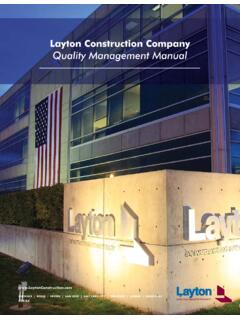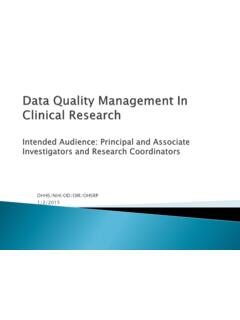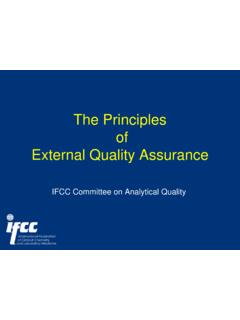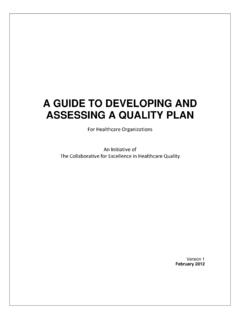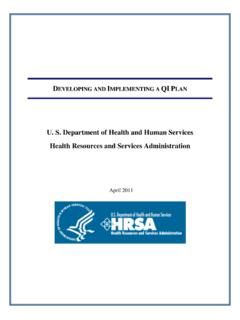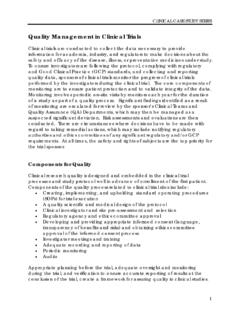Transcription of Assurance frameworks - GOV.UK
1 December 2012 Assurance frameworksAssurance frameworksDecember 2012 Official versions of this document are printed on 100% recycled paper. When you have finished with it please recycle it using an electronic version of the document, please consider the environment and only print the pages which you need and recycle them when you have finished. Crown copyright 2012 You may re-use this information (not including logos) free of charge in any format or medium, under the terms of the Open Government Licence. To view this licence, visit or write to the Information Policy Team, The National Archives, Kew, London TW9 4DU, or e-mail: queries regarding this publication should be sent to us at: 978-1-84532-974-7 PU1410 1 Contents Page Chapter 1 Introduction 3 Chapter 2 Key principles and concepts 5 Chapter 3 Getting started 9 Chapter 4 Regular reporting on Assurance and risk 11 Annex A Process overview 13 Annex B Example mapping 15 3 1 Introduction Purpose As expectations of organisations increase and available resources become more restricted, so do the constraints under which they operate and the risks that they face.
2 This guidance advises on how Assurance can best support Accounting Officers and Boards in central government departments and their arm s length bodies in the leadership of their organisations and in meeting their corporate governance obligations. It illustrates how risk and Assurance arrangements can be directed to meet the delivery and accountability needs of the Accounting Officer and Board, providing evidence-based assurances on the management of risks that threaten the successful achievement of public service delivery objectives and, in turn, report on these to Parliament and other stakeholders. It is essential that there is an effective and efficient framework in place to give sufficient, continuous and reliable Assurance on organisational stewardship and the management of the major risks to organisational success and delivery of improved, cost effective, public services.
3 This Assurance framework should be structured and provide reliable evidence to underpin the assessment of the risk and control environment for the annual Governance Statement, supported by independent appraisal from the internal audit service. The Governance Statement is a key feature of the organisation s annual report and accounts. It covers the organisation s corporate governance, risk management and internal control arrangements. The statement should incorporate an evaluation on how well the arrangements have operated in practice, based upon the ongoing assessment processes. There are many sources of Assurance in an organisation that can be harnessed to provide the body of evidence required to support the continuous assessment of the effectiveness of the management of risk and internal control.
4 Understanding the sources of Assurance and their scope means internal audit can focus most effectively on the riskier areas. The structured mapping of assurances is one of the fundamental steps in building an Assurance framework. This guidance sets out some key steps for both introducing arrangements for mapping and for monitoring assurances throughout the year. Further detail can be found in Chapter 2, including definitions of terms used. Responsibility The Accounting Officer, supported by the Board, is responsible for ensuring that there are robust governance, risk management and internal control arrangements across the whole organisation, including any sponsored bodies.
5 Authority, in terms of accountability and respective delegations, needs to be appropriately and clearly established and monitored. This responsibility includes the Accounting Officer demonstrating to Parliament that he/she has maintained a sound system of risk management and internal control in stewardship of the organisation s resources, which is affirmed in his/her signature of the Governance Statement. 4 Advice on and scrutiny of key risks is a matter for the Board. The Board will routinely monitor the mitigation of certain strategic risks. These will include risks of a sufficient magnitude to threaten organisational success and reputation, or a scenario of combined risks that would have a similarly devastating impact.
6 This supports the Accounting Officer in ensuring that there is regular and timely Assurance on the things that are important to organisational success; in particular, the proportionate management of risks that threaten the successful achievement of business outcomes and objectives. Whilst the Board will most closely monitor its key risks, it will otherwise delegate the monitoring of Assurance to an Audit and Risk Assurance Committee (ARAC), or appropriate equivalent body in the organisation, made up of independent Non Executive Directors. This is not a substitute for management s responsibility for the mitigation of risks. On behalf of the Board, the ARAC will examine the arrangements in place to provide comprehensive and reliable Assurance .
7 This involves identifying the Assurance need, how it will be met, whether there are any Assurance gaps or overlaps, how these can best be filled and whether this will provide the sufficient, relevant, reliable Assurance that it needs. These arrangements should be monitored throughout the year to ensure that sufficient Assurance is being planned and delivered to avoid surprises and to enable early decisions and action to be taken on risk and control issues. This will help to routinely validate Assurance . A good framework is required to support the governance process. Benefits There are significant benefits to improved co-ordination of Assurance .
8 Fundamental to these is the provision of streamlined and synchronised information on organisational performance and the management of associated risks, helping the organisation to operate efficiently and effectively and to report to parliament accurately, meaningfully and without misleading. More specifically, an effective Assurance framework: Provides timely and reliable information on the effectiveness of the management of major strategic risks and significant control issues; Facilitates escalation of risk and control issues requiring visibility and attention by senior management, by providing a cohesive and comprehensive view of Assurance across the risk environment; Provides an opportunity to identify gaps in Assurance needs that are vital to the organisation, and to plug them (including using internal audit) in a timely, efficient and effective manner.
9 Can be used to raise organisational understanding of its risk profile, and strengthen accountability and clarity of ownership of controls and Assurance thereon, avoiding duplication or overlap; Provides critical supporting evidence for the production of the Governance Statement; Can clarify, rationalise and consolidate multiple Assurance inputs, providing greater oversight of Assurance activities for the Board/Audit & Risk Assurance Committee in line with the risk appetite; and Facilitates better use of Assurance skills and resources. 5 2 Key principles and concepts Principles There are many mechanisms within an organisation that can help to provide information on how well performance and the associated risks to delivery are being managed.
10 An Assurance framework is a good mechanism for managing this in a structured, visible format, ensuring that the disparate Assurance mechanisms are harnessed and focused to provide the best results in a proportionate and effective manner. Pre-requisites for successful creation of an Assurance framework include: Support and direction from the Accounting Officer and ownership for the framework at Board level; Clarity on what you want it to achieve (particularly encompassing Board and Accounting Officer needs); Building the framework first within a manageable boundary (beginning with the high level strategic and key process risks); Simplicity don t try to cover too much in a single Assurance map (some organisations have different maps at different levels or separate maps for planning and evaluation); and Avoid technical jargon.










